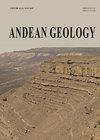Darriwilian (Middle Ordovician) conodonts and graptolites from the Cerro La Chilca Section, Central Precordillera, Argentina
IF 1.2
4区 地球科学
Q3 GEOLOGY
引用次数: 10
Abstract
The Ordovician System is extensively represented in the Precordillera of San Juan Province, Argentina. At the Cerro La Chilca in the Jachal area, the limestone of the San Juan Formation is paraconformably overlain by interbedded limestone and shale of the Gualcamayo Formation. The present contribution reports new data on the conodont fauna and biostratigraphy of these darriwilian units, revising local and regional chronostratigraphic relationships. New information on the composition of conodont and graptolite associations through the stratigraphic sequence is presented. The presence of Paroistodus horridus horridus, Yangtzeplacognathus crassus, and Histiodella sinuosa constrain the uppermost strata of the San Juan Formation to the lower part of the Y. crassus Zone, according to the Baltoscandian scheme, and to the H. sinuosa Subzone of the Periodon macrodentatus Zone of the North American scheme. In the overlying Gualcamayo Formation the co-occurrence of Y. crassus with Histiodella holodentata enable the recognition of the Y. crassus Zone and the H. holodentata Subzone of the P. macrodentatus Zone. The identification of these zones allows for precise global and regional correlation. A graptolite assemblage that belongs to the epipelagic and deep-water biotopes with some components restricted to low paleolatitudes is recognized. This diverse assemblage is characteristic of the pelagic biofacies. The important diversity of graptolites in this section suggests a favorable environment for their development. Local changes in the taxonomic composition are recognized through the Gualcamayo Formation. When comparing this fauna with that of different study localities from the Central Precordillera (Cerro Potrerillo, Oculta Creek, Cerro Viejo de Huaco and Las Aguaditas Creek) slight differences in the generic composition are observed. Taxonomic differences support the preference of certain associations for particular environments; though, graptolites are more diverse in black shales facies, which represent deeper environments (the Los Azules Formation), in relation to the calcareous-shale facies of the Gualcamayo Formation from Cerro La Chilca and correlative unit at Las Aguaditas Creek.阿根廷Precordillera中部Cerro La Chilca剖面的Darriwilian(中奥陶世)牙形刺和笔石
奥陶系广泛分布于阿根廷圣胡安省的Precordillera地区。在Jachal地区的Cerro La Chilca,圣胡安组的灰岩被Gualcamayo组的互层灰岩和页岩顺整合覆盖。本文报道了这些达里威利单位牙形石动物群和生物地层学的新资料,修订了当地和区域的年代地层关系。通过地层层序对牙形石和笔石组合的组成提供了新的信息。paristodus horridus horridus、Yangtzeplacognathus crassus和Histiodella sinuosa的存在,将圣胡安组的最上层地层限制在Baltoscandian模式下的Y. crassus带的下部,以及北美模式下的Periodon macrodentatus带的H. sinuosa亚带。在其上的Gualcamayo组中,粗齿杨与holododella holodentata的共存使得粗齿杨区和大齿杨区holodentata亚区得以识别。这些区域的识别允许进行精确的全球和区域关联。笔石组合属于上层海洋和深水生物群落,其中一些成分仅限于低古纬度。这种多样化的组合是远洋生物相的特征。该剖面笔石的重要多样性表明其具有良好的发育环境。分类组成的局部变化是通过瓜尔卡马约组来识别的。将该区系与中部Precordillera不同研究地点(Cerro Potrerillo、Oculta Creek、Cerro Viejo de Huaco和Las Aguaditas Creek)的区系进行比较,发现其属组成略有差异。分类学上的差异支持了某些种群对特定环境的偏好;然而,与Cerro La Chilca的Gualcamayo组的钙质页岩相和Las Aguaditas Creek的相关单元相比,黑色页岩相(Los Azules组)的笔石更加多样化,代表了更深的环境(Los Azules组)。
本文章由计算机程序翻译,如有差异,请以英文原文为准。
求助全文
约1分钟内获得全文
求助全文
来源期刊

Andean Geology
地学-地质学
CiteScore
3.90
自引率
0.00%
发文量
17
审稿时长
>12 weeks
期刊介绍:
This journal publishes original and review articles on geology and related sciences, in Spanish or English, in three issues a year (January, May and September). Articles or notes on major topics of broad interest in Earth Sciences dealing with the geology of South and Central America and Antarctica, and particularly of the Andes, are welcomed.
The journal is interested in publishing thematic sets of papers and accepts articles dealing with systematic Paleontology only if their main focus is the chronostratigraphical, paleoecological and/or paleogeographical importance of the taxa described therein.
 求助内容:
求助内容: 应助结果提醒方式:
应助结果提醒方式:


